List of crewed spacecraft
Crewed spacecraft are designed to support human life for the human spaceflight portion of the mission. Spacecraft for human spaceflight must have a human-rating certification as fit for purpose. Crewed spacecraft must be pressurised, usually between 800 mbar and 1 bar (1 atmosphere); temperature regulated, usually 20-24°C; and have a breathable atmosphere.
Crewed spacecraft can be space capsules, spaceplanes, and space stations.
This is a list of past, present, and future spacecraft designed for human spaceflight.
Comparison
Currently operational crewed spacecraft
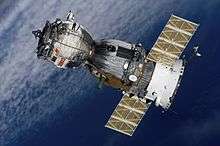
Soyuz-TMA spacecraft
Soyuz (1967)
- Russian - three person Earth orbital spacecraft;[1] Early versions were operated by the Soviet Union and later versions by Russia after 1991. As of April 2020 Soyuz has made 143 crewed spaceflights, including two emergency sub-orbital flights, Soyuz 18a and Soyuz MS-10. There have been 2 accidental spacecraft losses resulting in the deaths of four cosmonauts, Soyuz 1 and Soyuz 11. Soyuz is the only spacecraft to have successfully saved the lives of a crew using the rocket launch escape system, when in 1983 Soyuz T-10-1 exploded on the launchpad. This spacecraft type has flown into space more times than any other spacecraft, including the Space Shuttle.[2]
Shenzhou (2003)
- Chinese three person Earth orbital spacecraft. 6 flights as of April 2018. Shenzhou is China's first crewed spacecraft. On 13 October 2003 Yang Liwei was carried into space by Shenzhou 5 becoming China's first Taikonaut.[3]
SpaceShipTwo (2018)
- United States 8 person air-launched suborbital space plane operated by Virgin Galactic aimed at the space tourism market. On 31 October 2014 during a test flight, VSS Enterprise, the first SpaceShipTwo craft, broke up in flight and crashed in the Mojave desert.[4][5][6][7] One pilot was killed.[8][9] On 13 December 2018 SpaceShipTwo flew to an altitude of 82.7 km which is recognised as space by the FAA, NASA, and the USAF (although not the FAI)[10] This was the first time an American spacecraft had sent astronauts to space since the final Space Shuttle flight in 2011. VSS Unity flew to space again on 22 February 2019 to an apogee of 89.9 km (55.97 miles). Onboard was astronaut Dave Mackay, Michael Masucci and Beth Moses.
Crew Dragon (2020)
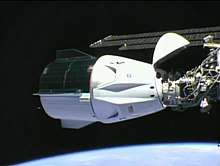
Crew Dragon Endeavour docked with the International Space Station
- United States seven person Earth orbital spacecraft designed by SpaceX to transport astronauts to the International Space Station under the NASA Commercial Crew Contract. Crew Dragon is capable of operating beyond Earth orbit. The first crewed flight launched on 30 May 2020. This was the first time an American spacecraft had sent astronauts to orbit since the final Space Shuttle flight in 2011. [11]
Currently operational space stations
International Space Station (2000)
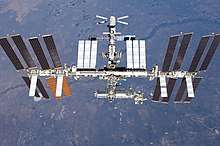
International Space Station
- Multinational low Earth orbit modular space station. The International Space Station is a joint project among five participating space agencies: NASA, Roscosmos, JAXA, ESA, and CSA.[12] Uncrewed initial assembly 1998-2000. Continuously crewed since November 2000. As of May 2020 ISS has been visited by 98 crewed spacecraft (62 Soyuz, 35 Space Shuttle, and 1 Crew Dragon). The ISS is the largest space station yet constructed. Planned to operate until 2024, with a possible extension to 2028.[13]
Former crewed spacecraft
Vostok (1961–1963)
- Soviet single-person Earth orbital spacecraft[14] 6 flights. On April 12, 1961 Vostok 1 carried the first human into space, Cosmonaut Yuri Gagarin.[15] On 16 June 1963 Vostok 6 carried the first woman into space, Cosmonaut Valentina Tereshkova.[16]
Mercury (1961–1963)
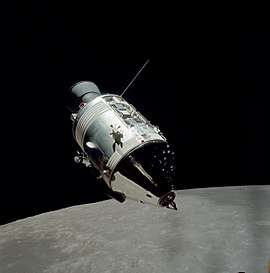
Apollo 17 CSM orbiting the Moon.
- United States single-person Earth orbital spacecraft[17] 6 flights (including 2 sub-orbital). Mercury was the United States first crewed spacecraft. On 5 May 1961 Mercury-Redstone 3 carried the first American, Alan Shepard, into space on a sub-orbital flight. On 20 February 1962 Mercury-Atlas 6 carried the first American, John Glenn, into Earth orbit.[18]
X-15 (1962–1968)
- United States single seat, air-launched spaceplane; two X-15 flights above the 100 km Kármán line occurred in 1963, an additional 11 flights between 1962 and 1968 reached altitudes between 80–100 km which were recognised as spaceflights by US authorities.[19]
Voskhod (1964–1965)
- Soviet three person Vostok derivative[20] 2 flights. On 18 March 1965 Alexei Leonov performed the first spacewalk in history, from Voskhod 2 - which was also the first multi-crew mission.[21]
Gemini (1965–1966)
Apollo (1968–1975)
- United States three person lunar-capable spacecraft. 15 flights; including nine lunar missions (with six lunar landings). It was the Apollo spacecraft that enabled America to win the Space Race. In December 1968 Apollo 8 was the first crewed spacecraft to orbit the Moon. On 21 July 1969 Neil Armstrong, the Commander of Apollo 11, and Buzz Aldrin became the first humans to walk on the Moon.[24] The Apollo Spacecraft comprised
- 1. Command and service module (1968–1975) three person Earth and lunar orbital craft[25]
- 2. Apollo Lunar Module (1969–1972) two person lunar lander[26]
Space Shuttle (1981–2011)

Space Shuttle Challenger in orbit
- United States eight person Earth orbital spacecraft; first orbit-capable spaceplane; first reusable orbital spacecraft. Largest cargo capacity to orbit. 135 spaceflights were made in five shuttles; Columbia, Challenger, Discovery, Atlantis, and Endeavour, of which two (Challenger and Columbia) were accidentally destroyed resulting in the deaths of 14 astronauts during missions STS-51-L and STS-107.[27]
SpaceShipOne (2004)
- United States single seat, air-launched spaceplane; three flights above the Kármán line occurred in 2004.[28]
Former space stations
Salyut series (1971–1991)
Skylab (1973–1974)
- United States low Earth orbit space station. First United States space station. Three crews. De-orbited 1979.[31]
Almaz series (1973–1977)
Mir (1986–2000)
- Soviet/Russian low Earth orbit modular space station. The first modular space station in history. 28 crews. Mir was visited by 29 Soyuz and 7 Space Shuttle missions, and was de-orbited in 2001.[32]
Tiangong 1 (2012–2013)
- Chinese low Earth orbit space station. China's first space station launched in 2011. Visited by two crews. It was deorbited in 2018.
Tiangong 2 (2016)
- Chinese low Earth orbit space station. China's second space station. Launched in 2016. Visited by one crew. It was deorbited in 2019.
Crewed spacecraft in development
Blue Origin's New Shepard
- United States six person capsule mounted on a reusable vertical launch sub-orbital rocket aimed at the space tourism market. As of March 2020 there have been 12 successful uncrewed flights since 2015, with 11 successful rocket booster landings. First crewed test-flight expected in 2020 [33]
Boeing's CST-100 Starliner
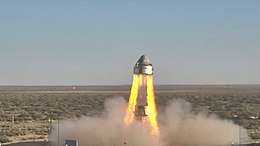
Starliner performing a pad abort test in 2019
- United States seven person Earth orbital spacecraft designed to transport astronauts to the International Space Station under the NASA Commercial Crew Contract. Following several technical problems on the first uncrewed test flight in December 2019, a second uncrewed test flight will be flown in late 2020, with the first crewed flight expected in 2021[34].
New unnamed Chinese spacecraft
- Chinese replacement for Shenzhou is a six person lunar capable spacecraft. An uncrewed flight took place on 05 May 2020, with a crewed flight possible by 2021. Initial flights will be to the new Chinese space station, lunar missions are expected in the 2030s.[35]
SpaceX Starship
- Planned to be a fully reusable inter-planetary spacecraft capable of carrying 100 passengers or cargo. Primarily designed for Mars missions it is to be capable of landing on all rocky planets or moons in the Solar System except Venus.[36] For Earth launches Starship will need a two stage configuration with the addition of a powerful first stage booster called Super-Heavy. Flights from all other planetary bodies will not require a first stage booster. Starship will require refuelling in Earth orbit to enable it to reach other Solar System destinations, so there will be three distinct Crew, Cargo and Tanker variants [37] [38]Uncrewed test flights are expected to take place in 2020 from Boca Chica, Texas. A private crewed mission to slingshot around the Moon, the dearMoon project, is planned for 2023.[39]
NASA's Orion
- A spacecraft capable of lunar missions with a crew of four, planned to be used as part of NASA's Artemis program. Consisting of two components – a Crew Module (CM) manufactured by Lockheed Martin, and a European Service Module (ESM) manufactured by Airbus Defence and Space – the spacecraft are designed to support crewed exploration beyond low Earth orbit. Orion is equipped with solar power, an automated docking system, and glass cockpit interfaces modeled after those used in the Boeing 787 Dreamliner, and can support a crew of six in low Earth orbit and a crew of four in lunar orbit, up to 21 days undocked and up to six months docked. A single AJ10 engine provides the spacecraft's primary propulsion, while eight R-4D-11 engines and six pods of custom reaction control system engines developed by Airbus provide the spacecraft's secondary propulsion. Although compatible with other launch vehicles, Orion is primarily designed to launch atop a Space Launch System (SLS) rocket, with a tower launch escape system. The first crewed mission Artemis 2 is planned for late 2022 and will slingshot around the Moon. The following crewed Artemis 3 flight is planned for late 2024 and will be a lunar landing mission.
Gaganyaan
- A three-person Earth orbital spacecraft intended to be the first crewed spacecraft of the Indian Human Spaceflight Programme. Gaganyaan will be capable of operating at low Earth orbit for up to 7 days. The upgraded version will be equipped with rendezvous and docking capabilities. Its first crewed flight is planned for 2022 and four Indian astronauts have begun flight training in Russia.[40]
Sierra Nevada's Dream Chaser
Orel
- Russian four person lunar-capable spacecraft to enable the retirement of Soyuz. The first crewed flight is planned for 2025.[43]
Crewed spacecraft - planned
- Chinese reusable Lift-body Launcher - China plans to launch its reusable spaceplane in 2020, according to a statement from China Aerospace Science and Technology Corporation.[44]
- Chinese winged rocket - the plane may one day fly up passengers to the edge of space. Two versions: one should be able to fly five people to an altitude of 100 kilometres; other - could fly 20 people to 130 kilometres. Payload launches in 2020.[45]
- RSSC - a Russian reusable sub-orbital space complex, currently being developed by a private company KosmoKurs. First flight planned for 2021.[46][47]
- Japanese sub-orbital rocket plane currently being developed by PD Aerospace. First flight planned for 2020 and fully operational by 2023.[48]
- Selena - NPO "Aerospace Technologies" (НПО «Авиационно-космические технологии») suborbital, space yacht [49]
- Thunderstar - a 12-metre crewed rocket for one person.[50]
Space stations in development
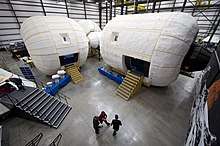
Mockup of Bigelow's Space Station
- Chinese large modular space station (CSS) - scheduled to start with the launch of the Tianhe-1 module in 2020, and to be completed by 2022[51]
- Bigelow Commercial Space Station or Space Complex Alpha, proposed private space habitat scheduled for 2020 initial deployment. A Bigelow test module is currently installed on the International Space Station.[52]
- Lunar Gateway - NASA proposed international crewed space station orbiting the Moon to be assembled by commercial launch vehicles from 2022.[53]
- OPSEK, proposed Russian successor to the International Space Station.[54]
- Lunar Orbital Station, a proposed Russian lunar orbiting space station.
- ISRO orbital station- proposed to be launched after gaganyaan mission
See also
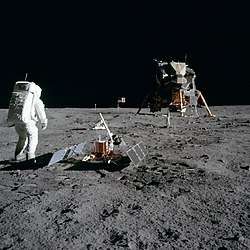
Apollo 11 Lunar Module Eagle
References
- Gatland, pp.148-165
- Hollingham, Richard. "Soyuz: The Soviet space survivor".
- "Shenzhou Manned Spacecraft Programme". Aerospace Technology. 2012-06-16. Retrieved 2018-08-26.
- Chang, Kenneth; Schwartz, John (31 October 2014). "Virgin Galactic's SpaceShipTwo Crashes in New Setback for Commercial Spaceflight". New York Times. Retrieved 1 November 2014.
- Foust, Jeff (2014-10-31). "SpaceShipTwo Destroyed in Fatal Test Flight Accident". Space News. Retrieved 2014-10-31.
- "Virgin Galactic's SpaceShipTwo Crashes During Flight Test". October 31, 2014.
- Durden, Rick (31 October 2014). "Virgin Galactic's SpaceShipTwo Crashes". AVweb. Retrieved 31 October 2014.
- Klotz, Irene (2014-11-03). "SpaceShipTwo's Rocket Engine Did Not Cause Fatal Crash". Discovery News. Retrieved 2014-11-03.
- "Virgin Galactic's SpaceShipTwo rocket plane crashes". October 31, 2014.
- https://www.theguardian.com/science/2018/dec/13/virgin-galactic-spaceshiptwo-launch-california-edge-of-space
- https://www.space.com/spacex-crew-dragon-nasa-astronauts-demo-2-launch-date.html
- "Human Spaceflight and Exploration—European Participating States". European Space Agency (ESA). 2009. Retrieved 17 January 2009.
- "International Space Station: Facts, History & Tracking".
- Gatland, pp.109-115
- "Archived copy" (PDF). Archived from the original (PDF) on 2017-02-07. Retrieved 2018-04-02.CS1 maint: archived copy as title (link)
- "Valentina Tereshkova: First Woman in Space".
- Gatland, pp.148, 151-165
- Loff, Sarah (6 April 2015). "About Project Mercury".
- Long, Tony (2007-07-19). "July 19, 1963: Cracking the 100-Kilometer-High Barrier ... in a Plane". Advance Publications. Retrieved 18 November 2011.
- Gatland, pp.131-113
- "The First Spacewalk".
- Gatland, pp.166-185, 266-275
- "The First U.S. Spacewalk - Gemini 4". nssdc.gsfc.nasa.gov.
- "What Was the Apollo Program?". 24 February 2015.
- Gatland, pp.190, 278-280
- Gatland, pp.191, 207, 283, 284
- Taylor, Alan. "The History of the Space Shuttle".
- "SpaceShipOne: The First Private Spacecraft - The Most Amazing Flying Machines Ever".
- Gatland, pp.229-246
- "Space Station - The Station - Russian Space History". www.pbs.org.
- "History of the NASA Skylab, America's first space station".
- "Mir Space Station". history.nasa.gov.
- https://spaceflightnow.com/2019/12/11/blue-origin-launches-new-shepard-on-12th-test-flight/
- http://www.parabolicarc.com/2020/04/06/boeing-to-refly-automated-starliner-flight-test/
- https://www.space.com/china-new-spacecraft-crewed-moon-missions.html
- Lawler, Richard (20 November 2018). "SpaceX BFR has a new name: Starship". Engadget. Retrieved 21 November 2018.
- Boyle, Alan (19 November 2018). "Goodbye, BFR … hello, Starship: Elon Musk gives a classic name to his Mars spaceship". GeekWire. Retrieved 22 November 2018.
Starship is the spaceship/upper stage & Super Heavy is the rocket booster needed to escape Earth's deep gravity well (not needed for other planets or moons)
. - "Starship". SpaceX. Retrieved 2 October 2019.
- https://www.space.com/spacex-starship-moon-missions-2022.html
- https://www.livemint.com/news/india/4-astronauts-for-india-s-first-manned-mission-to-space-gaganyaan-identified-isro-11577873182776.html
- Ferster, Warren (2011-04-18). "NASA Announces CCDev 2 Awards". Imaginova Corp. Retrieved 18 November 2011.
- https://spacepolicyonline.com/news/dream-chaser-on-track-for-2021-cargo-mission-crew-within-5-years/
- http://www.spacedaily.com/reports/Russian_Space_Agency_commits_billions_of_rubles_more_to_Oryol_next_gen_spacecraft_999.html
- "China will launch a reusable spaceplane in 2020 – NextBigFuture.com". www.nextbigfuture.com.
- "China plans world's biggest spaceplane to carry 20 tourists".
- "Archived copy". Archived from the original on 2016-11-14. Retrieved 2016-11-13.CS1 maint: archived copy as title (link)
- "КосмоКурс - Главная". www.cosmocourse.com.
- Chandran, Nyshka (12 April 2017). "SpaceX doesn't scare Asia's space players".
- "Starchaser Industries Commercial Space Access • The sky is not the limit!". Starchaser.co.uk. 2017-09-11. Retrieved 2018-08-26.
- "China readying for space station era: Yang Liwei - Xinhua - English.news.cn". www.xinhuanet.com.
- "A new company plans to launch huge, inflatable spacecraft into orbit — and sell reservations to countries and tourists".
- Warner, Cheryl (13 February 2018). "NASA's Lunar Outpost will Extend Human Presence in Deep Space".
- "Orbital Piloted Assembly and Experiment Complex, OPSEK". www.russianspaceweb.com.
Sources
- Gatland, Kenneth (1976). Manned Spacecraft (2nd ed.). New York City: MacMillan Publishing Co., Inc. ISBN 0-02-542820-9.
This article is issued from Wikipedia. The text is licensed under Creative Commons - Attribution - Sharealike. Additional terms may apply for the media files.

.jpg)